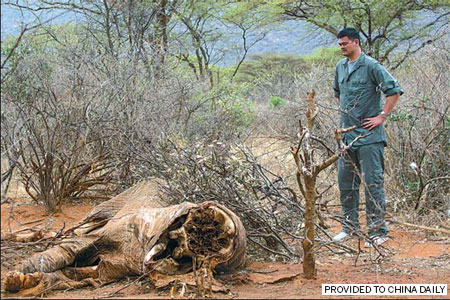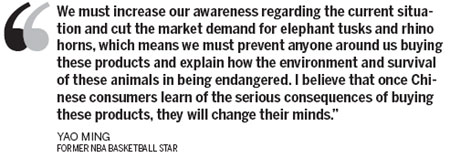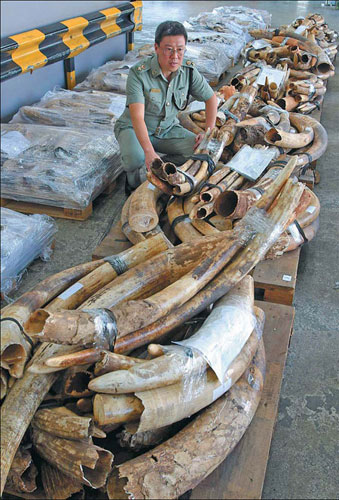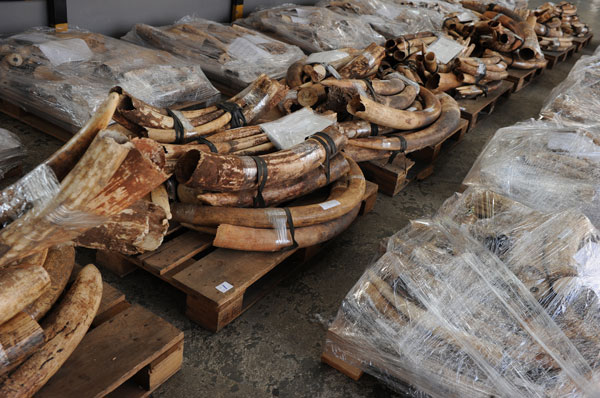No horns of a dilemma over conservation
Updated: 2012-10-22 07:41
By Li Lianxing (China Daily)
|
|||||||||||
Rising awareness
Ge Liwen, a recent graduate who majored in Korean and is now responsible for recruiting volunteers for Zhuo's team in China, said awareness of animal protection in countries such as Kenya or South Africa has increased dramatically at her college, but there's still a long way to go.
"People used to lack the means to understand the big picture about wildlife products. They probably thought that buying one or two items would have a minimal impact on the overall situation, but in fact those small pieces at home amount to slaughter on the savannah," said Ge.
"I know it's not just a passing whim but a lifetime commitment, because everything we do here is connected to the fate of animals in Africa," she said. "If no one stands up and backs us, the animals will live in desperation."
Other volunteers, such as Liu Mingyu, have greater professional experience. The young graduate has a plan for wildlife protection overseas, one that could possibly see him becoming the next "Simba".
"I studied biology in college and was involved with several animal protection programs in China until I learned of the deteriorating situation in Africa," he said. "Educating the public about wildlife concerns and gaining a further degree in protective biology will be my contribution in the near future."
As a volunteer who has seen the killing sites in African nature reserves, Liu said he has an obligation to let those who have bought ivory, rhino horns or other wildlife products know what a bloody trade they have engaged in.
"I must do something I love and meaningful in this, the prime of my life," he added.
Zhuo said an increasing number of well-to-do Chinese have indicated great interest in his animal protection project and, after seeing his promotional material, have vowed not to buy wildlife products.
"This indicates progress," said Zhuo. "They don't have to come to Africa to display their dedication, some have joined the campaign by supporting me financially."
He said Chinese awareness of international wildlife protection is still in its infancy, but the future looks promising.
Independent Asian wildlife protection organizations such as Zhuo's are hard to find in Africa. However, Japan, once a major consumer of wildlife products, sends volunteers to the Kenya Wildlife Service, the state body charged with protecting wildlife, to work on public education programs.
"It's vital to learn about the situation on the ground and then return to Japan to tell the full story to the Japanese people," said Shinnosuke Tachio, a volunteer from the Japanese International Cooperation Agency.
Ivory prices soar
The soaring price of ivory is the biggest driver of the continued rise in elephant poaching, according to Paul Muya.
A 2011 report published by the Kenyan Wildlife Service and other organizations said the price of tusks from the largest elephants poached in the north of the country was equal to 18 months' salary for a wildlife ranger, or 15 years' salary for an unskilled worker. Currently the price is around 18,000 Kenyan shillings ($211) per kg.
The new wealth in China worries animal protection groups. "There is more disposable income in China today than at any time in history. Ivory has the cachet of being a luxury-status commodity and more people than ever are able to own a piece now," said Tom Milliken, global elephant and rhino program leader for a wildlife trade monitoring network called Traffic, which described 2011 as an "annus horribilis" for African elephants in a report.
The ivory trade boomed in the late 19th century, bringing Africa's first wave of wholesale elephant slaughter, although things improved when measures to regulate the trade were introduced in the early part of the last century.
However, rising prosperity in the Asian region, especially in Japan, in the 1970s and '80s saw the animals come under attack once again, according to the Kenyan Wildlife Service.
An estimated minimum population of 1.3 million in 1979 had fallen to half that number by the mid-1980s and to approximately 450,000 by 2007, according to testimony provided to the United States Congress by Iain Douglas-Hamilton, a founder member of Save the Elephants, who has been conducting research into African elephants for more than 45 years.
And the trade doesn't just encompass carvings and artworks - some people still believe that powered rhino horn is a medicine or tonic and has great nutritional value. In fact, the horn is mainly composed of bone covered by a layer of keratin, a substance also found in human hair and nails. In 1993, the Chinese government banned the use of rhino horn as a medicine.
Kenya isn't the only country experiencing problems with poachers, of course. Since the beginning of this year, 388 rhino have been killed by poachers in South Africa's Kruger National Park and provinces such as Limpopo, KwaZulu-Natal and North West, according to the country's government statistics.
|
 |
|
 |
The country is home to approximately 22,000 white and 4,800 black rhino, which are native to Africa and represent 93 percent of the world's total population.
"The illegal wildlife trade in the 21st century has an estimated value of $7.8 billion to $10 billion per annum, a figure which, if correct, would make it the fifth-largest illicit transnational activity globally, after counterfeiting and the illegal trades in drugs, people and oil," according to Douglas-Hamilton.
The eradication of poaching in Africa depends on rooting out the market for the products, which in this case is mainly in Asia, because the high demand is still the key driver behind poaching.
"We must increase our awareness regarding the current situation and cut the market demand for elephant tusks and rhino horns, which means we must prevent anyone around us buying these products and explain how the environment and survival of these animals in being endangered," said Yao Ming after his visit to Africa.
"I believe that once Chinese consumers learn of the serious consequences of buying these products, they will change their minds," he said.
 |
|
More than 1,200 elephant tusks are put on display in Hong Kong on Saturday. The largest seizure of smuggled ivory in Hong Kong was made during a joint operation with authorities in Guangdong province. [Photo/Agencies] |
Contact the reporter at lilianxing@chinadaily.com.cn
Related Stories
Hard battle against migratory bird hunting 2012-10-16 11:04
Yao charms Kenyans with height on conservancy mission 2012-08-18 14:35
Poachers arrested on charge of killing bears with bombs 2012-07-04 20:09
HK makes largest ivory seizure worth $3.5m 2012-10-21 15:35
China opposes ivory smuggling 2012-09-05 18:09
Today's Top News
President Xi confident in recovery from quake
H7N9 update: 104 cases, 21 deaths
Telecom workers restore links
Coal mine blast kills 18 in Jilin
Intl scholarship puts China on the map
More bird flu patients discharged
Gold loses sheen, but still a safe bet
US 'turns blind eye to human rights'
Hot Topics
Lunar probe , China growth forecasts, Emission rules get tougher, China seen through 'colored lens', International board,
Editor's Picks

|

|

|

|

|

|






